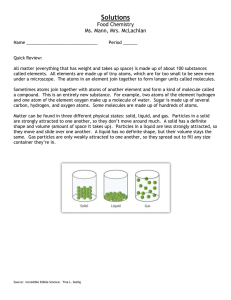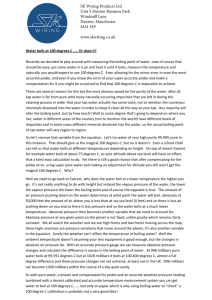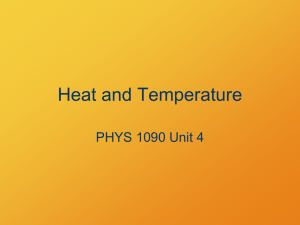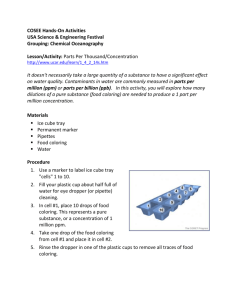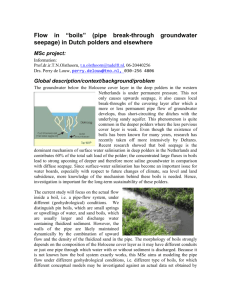Chemistry 1 Test Review
advertisement
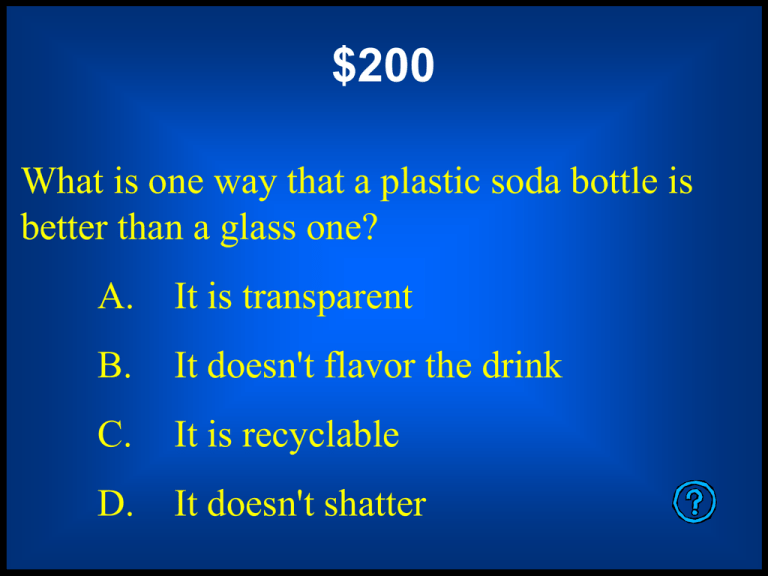
$200 What is one way that a plastic soda bottle is better than a glass one? A. It is transparent B. It doesn't flavor the drink C. It is recyclable D. It doesn't shatter $400 A student out on a hike finds an interesting rock. He observes the rock and looks on the Internet to see if he can find out its name. How is the student using scientific methods? A. he is out hiking and looking all around. B. he is using the Internet to look up information. C. he is classifying a substance based on its characteristics. D. he is dong an experiment with a controlled variable. $600 1 kg of the compound toluene melts at -95oC. What will happen to 500 g of toluene? A. melt at -47oC B. melt at -95oC C. boil at 95oC D. boil at 47.5oC $800 Marie Curie was the first scientist to purify and name the substance Radon. What must she have done to describe Radon to other scientists? A. discovered its chemical and physical properties B. taken pictures of it and shown them to others C. described the equipment she used to purify Radon D. looked all over the world for other samples of pure Radon $200 A scientist places 10 mL of water in a test tube and heats the liquid over a Bunsen burner for 2 minutes. The liquid boils and escapes as steam. This experiment is a good example of A. a chemical change involving phase changes B. a physical change involving phase changes C. a chemical change involving chemical reactions D. a physical change involving chemical reactions $400 Which of the following is an example of a physical change? A. lighting a match B. breaking a glass C. burning of gasoline D. rusting of iron $600 Which of the following examples is evidence of a physical change? A. Ice cream melts in a bowl. B. A silver spoon tarnishes over time. C. An electrical current splits water into hydrogen and oxygen. D. A person inhales oxygen and exhales carbon dioxide and water. $800 Which of the following is an example of a physical change? A. evaporation in a swamp cooler B. electricity produced by a dry cell C. digestion of a hamburger D. rusting of a car body $1000 Which of the following is an example of a physical change but not a chemical change? A. A log gives off heat and light as it burns. B. A tree stores energy from the Sun in its fruit. C. A penny lost in the grass slowly changes color. D. A water pipe freezes and cracks on a cold night. $200 The scientific discovery of the chemical and physical properties of atoms took place over several centuries. Which discoveries were the most important to understand atoms? A. finding the boiling and melting points of the substances B. the discoveries that helped us know that gasses had mass and volume. C. the discoveries showing that all the Earth’s crust was solid. D. each discovery was important because it would often lead to another. $400 If four carbon atoms undergo a chemical reaction with oxygen to form CO2 molecules, how many carbon atoms will be found in the product? A. one B. two C. three D. four $600 One hot August afternoon you spill your ice water on the sidewalk, and you watch the ice quickly start to melt. Sometime later, you walk by again but there is no sign of your spill. Which drawing below best shows what happened to the ice? A. B. C. $800 The Law of Conservation of Mass states that matter is not gained or lost in a chemical reaction. Which of the following correctly restates this law? In a chemical reaction A. the amount of mass of the reactants will equal the mass of the products. B. the amount of mass is equal to the sum of the reactants and products. C. matter is gained and lost in depending on how much energy is added. D. matter is gained and lost but energy is conserved. $1000 Which are the reactants in this reaction? A. B. B. C. D. $200 Water is placed over a burner and it boils. The graph shows the temperature at each 2-minute interval. The experiment ended at 20 minutes. How hot was the water at 6 minutes? A. 10°C B. 20°C C. 30°C D. 40°C $400 Water is placed over a burner and it boils. The graph shows the temperature at each 2-minute interval. The experiment ended at 20 minutes. At which point on the graph do the molecules have the most energy? A. A B. B C. C D. D $600 Water is placed over a burner and it boils. The graph shows the temperature at each 2-minute interval. The experiment ended at 20 minutes. If the water were left to boil for 10 minutes more, how hot would it get? A.32°C B.100°C C.160°C D.212°C $800 The boiling point of water at sea level is 100 degrees Celsius. What phase would you expect water to be if it were heated to 110 degrees Celsius? A. solid, because the molecules are moving more slowly B. liquid, because some of the molecules are still boiling at 110 degrees. C. gas, all the molecules have enough energy to have escaped at 110 degrees. D. plasma, all the molecules have enough energy to glow $1000 At which point is a phase change taking place? A. A B. B C. C D. E $200 What are on the inside of a nucleus of an atom? A. Protons and electrons B. Protons and neutrons C. Neutrons and electrons D. Electrons and quarks $400 Toniqua and Juan decide to do an experiment. One of them will put a drop of food coloring in hot water; the other will put a drop of food coloring in cold water. Based on your knowledge of energy and the motion of particles in a substance, predict the results of their experiment. A. The coloring will move through both containers of water at the same speed because water always has the same energy B. The coloring will move through the cold water faster because cold water has more energy C. The coloring will move through the hot water faster because hot water has more energy D. The coloring will float on top of the water until your put energy into it by stirring it $600 A student is making vegetable soup on a stovetop. He learned in science class that liquids boil at the same temperature until they change to a gas. How will what he learned help him cook the soup and save energy? A. he will turn the heat up so that it just barely boils. B. he will turn the heat up a little under where it needs to be for boiling. C. he will turn the heat up much hotter than needed for boiling. D. he will add water to the soup until it boils. $1000 The law of conservation of mass can be demonstrated by a chemical reaction. Which of the following models of a chemical reaction best represents the law of conservation of mass? A. B. C. D.
